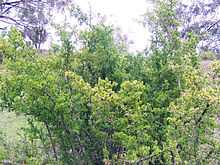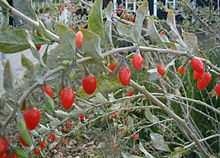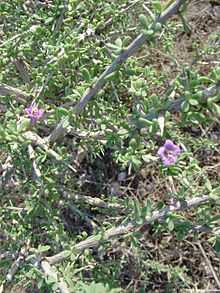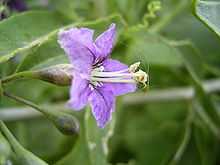Lycium
| Lycium | |
|---|---|
 | |
| African boxthorn (Lycium ferocissimum) | |
| Scientific classification | |
| Kingdom: | Plantae |
| (unranked): | Angiosperms |
| (unranked): | Eudicots |
| (unranked): | Asterids |
| Order: | Solanales |
| Family: | Solanaceae |
| Subfamily: | Solanoideae |
| Tribe: | Lycieae[1] |
| Genus: | Lycium L.[2] |
| Species | |
|
About 70-80, see text | |
| Synonyms | |
|
Cantalea Raf. | |
Lycium is a genus of flowering plants in the nightshade family, Solanaceae. The genus has a disjunct distribution across the globe, with species occurring on most continents in temperate and subtropical regions. South America has the most species, followed by North America and southern Africa. There are several scattered across Europe and Asia, and one is native to Australia.[3]
The generic name is derived from the Greek word λυκιον (lycion), which was applied by Pliny the Elder (23-79) and Pedanius Dioscorides (ca. 40-90) to a plant known as dyer's buckthorn. It was probably a Rhamnus species and was named for Lycia, the province in which it grew.[4] General common names for the genus include box-thorn,[5] desert-thorn, and wolfberry.[6]
There are about 70[3] to 80[7][8] species.
Description
Lycium are shrubs, often thorny, growing 1 to 4 meters tall. The leaves are small, narrow, and fleshy, and are alternately arranged, sometimes in fascicles. Flowers are solitary or borne in clusters. The funnel-shaped or bell-shaped corolla is white, green, or purple in color. The fruit is a two-chambered, usually fleshy and juicy berry which can be red, orange, yellow, or black. It may have few seeds or many.[5][7] Most Lycium have fleshy, red berries with over 10 seeds, but a few American taxa have hard fruits with two seeds.[8]
While most Lycium are monoecious, producing bisexual flowers with functional male and female parts, some species are gynodioecious, with some individuals bearing bisexual flowers and some producing functionally female flowers.[9]
Uses
Lycium has been known to European herbalists since ancient times and species were traded from the Far East to Europe by the Romans already, for example via Ariaca and the port of Barbarikon near today's Karachi, as mentioned in the Periplus of the Erythraean Sea. In his Naturalis historia, Pliny the Elder describes boxthorn as a medicinal plant recommended as a treatment for sore eyes and inflammation, as does Pedanius Dioscorides in his P. Dioscoridae pharmacorum simplicium reique medicae.[10]
Boxthorn is mentioned in the biblical Book of Proverbs as besetting the paths of the wicked (Proverbs 22:5). In his 1753 publication Species Plantarum, Linnaeus describes three Lycium species: L. afrum, L. barbarum, and L. europaeum.[10]

Lycium, particularly L. barbarum, have long been used in traditional Chinese medicine to treat conditions such as male infertility.[11] The fruit of L. barbatum and L. chinense, known as Goji, has recently become popular in western cultures for its supposed promotion of weight loss and general longevity.[12] The Chinese tonic Fructus Lycii (Gou-Qi-Zi) is made of the fruit of any of several Lycium species, and is used as a supplement, especially for eye health.[13]
Ecology
Lycium species mostly occur in arid and semi-arid climates, and a few are known from coastal zones in somewhat saline habitat types.[3]
Invasive species include L. ferocissimum, which was introduced to Australia and New Zealand and has become a dense, thorny pest plant there. It injures livestock, harbors pest mammals and insects, and displaces native species.[14]
Selected species


|
|
Formerly placed here
- Serissa japonica (Thunb.) Thunb. (as L. foetidum L.f. or L. japonicum Thunb.)[15]
References
| Wikimedia Commons has media related to Lycium. |
| Wikispecies has information related to: Lycium |
- ↑ "Genus Lycium". Taxonomy. UniProt. Retrieved 2009-04-16.
- ↑ 2.0 2.1 "Genus: Lycium L.". Germplasm Resources Information Network. United States Department of Agriculture. 2009-09-01. Retrieved 2010-12-13.
- ↑ 3.0 3.1 3.2 Fukuda, T., et al. (2001). Phylogeny and biogeography of the genus Lycium (Solanaceae): Inferences from chloroplast DNA sequences. Molecular Phylogenetics and Evolution 19(2), 246-58.
- ↑ Austin, D. F. (2004). Florida Ethnobotany. CRC Press. p. 677. ISBN 9780849323324.
- ↑ 5.0 5.1 Lycium. The Jepson eFlora 2013.
- ↑ Lycium. Integrated Taxonomic Information System (ITIS).
- ↑ 7.0 7.1 Lycium. Flora of China.
- ↑ 8.0 8.1 Levin, R. A. and J. S. Miller. (2005). Relationships within tribe Lycieae (Solanaceae): paraphyly of Lycium and multiple origins of gender dimorphism. American Journal of Botany 92(12), 2044-53.
- ↑ Miller, J. S. and D. L. Venable. (2002). The transition to gender dimorphism on an evolutionary background of self-incompatibility: an example from Lycium (Solanaceae). American Journal of Botany 89(12), 1907-15.
- ↑ 10.0 10.1 Hitchcock, C. L. (1932). A monographic study of the genus Lycium of the Western Hemisphere. Annals of the Missouri Botanical Garden 19(2/3), 179-348 and 350-66. doi:10.2307/2394155 (First page image).
- ↑ Luo, Q., et al. (2006). Lycium barbarum polysaccharides: Protective effects against heat-induced damage of rat testes and H2O2-induced DNA damage in mouse testicular cells and beneficial effect on sexual behavior and reproductive function of hemicastrated rats. Life Sciences 79(7), 613-21.
- ↑ Ballarín, S. M., et al. (2011). Anaphylaxis associated with the ingestion of Goji berries (Lycium barbarum). J Investig Allergol Clin Immunol 21(7), 567-70.
- ↑ Peng, Y., et al. (2005). Quantification of zeaxanthin dipalmitate and total carotenoids in lycium fruits (Fructus Lycii). Plant Foods for Human Nutrition 60(4), 161-64.
- ↑ Lycium ferocissimum (African boxthorn). Invasive Species Compendium. CABI.
- ↑ 15.0 15.1 "GRIN Species Records of Lycium". Germplasm Resources Information Network. United States Department of Agriculture. Retrieved 2010-12-13.
- ↑ "Lycium". Integrated Taxonomic Information System. Retrieved 2010-12-13.
External links
- Project Lycieae. Amherst College.
